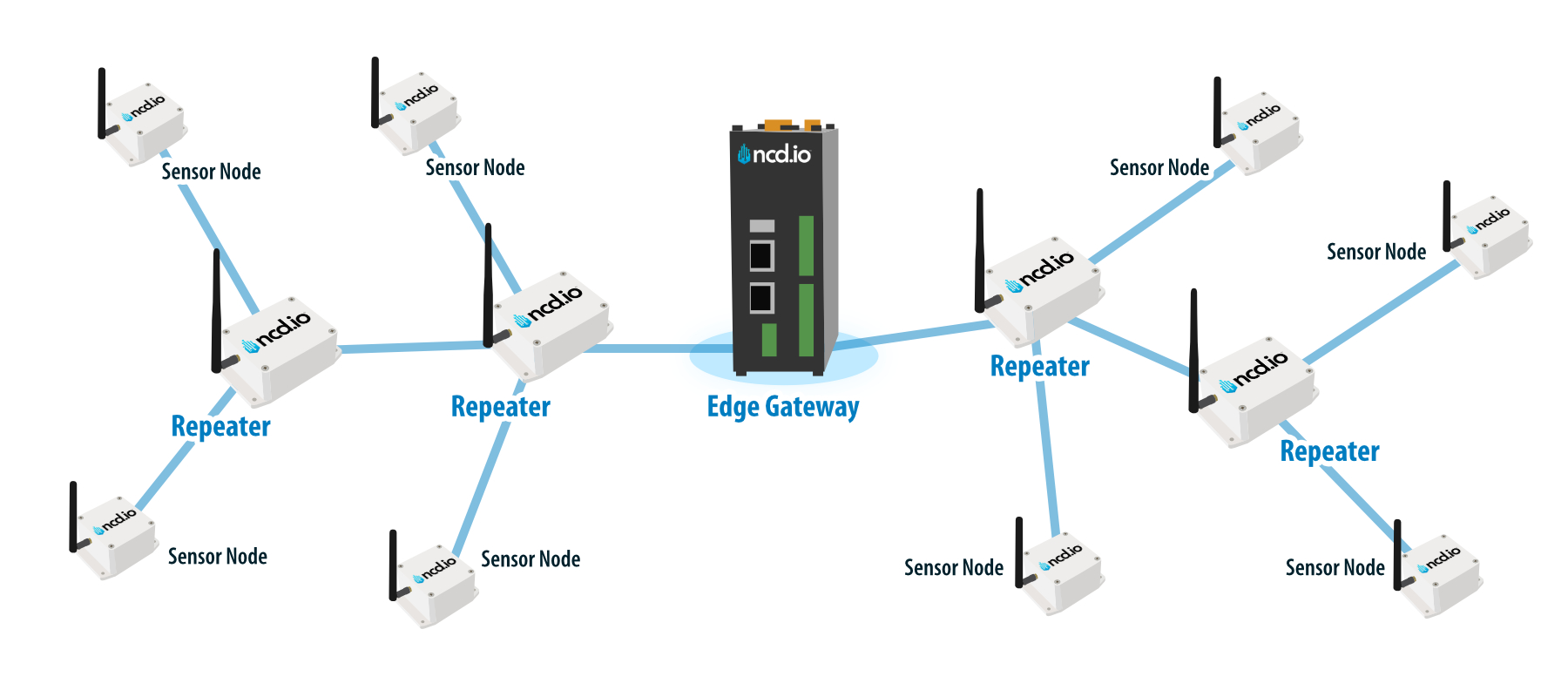Device Overview
NCD’s Long Range Industrial IoT Wireless CO2 Temperature Humidity Sensor offers air quality monitoring with an integrated temperature and humidity sensor, featuring up to a 2-mile range using wireless mesh networking. It transmits accurate CO2 concentration, temperature, and humidity data at user-defined intervals. CMOSens® technology provides precise CO2 measurements, while NDIR technology and a high-quality humidity and temperature sensor enhance accuracy.
The sensor compensates for long-term drifts using a dual-channel design, and its compact size allows easy integration. It operates from -25°C to 85°C and 0-90% RH, powered by 6 AA batteries with up to 5 years of life, depending on use. Its range, accuracy, and battery life make it a cost-effective solution for industrial and consumer applications.
Feature
- Industrial Grade CO2 Measurement Range 0 – 2’000 ppm
- CO2 Measurement Accuracy ± (60 ppm + + 5% of reading)(25 °C, 400 – 2’000 ppm)
- Repeatability 10 ppm and Temperature stability
- NDIR measurement principle
- Temperature compensation of CO2 sensor signal
- Fully calibrated and linearized
- Superior long-term stability With Built-in reference channel
- Industrial Grade Sensor with 0 to 90% RH / -25°C [-13°F] to 85°C [185°F])
- Resolution 0.4% RH/0.1°C Accuracy 6% RH/ 0.8°C
- Includes Battery Level with Every Transmission
- Validates and Retries Lost Communication Packets
- Encrypted Wireless Communications up to 2 Mile Range

Wireless Technology

The NCD Industrial range of sensors utilizes DigiMesh, a proprietary networking technology designed by Digi® International. It is especially suitable for IIoT applications as it provides a number of benefits over conventional wireless stacks:
- Long range – up to 1000 feet in urban environments and 2 miles+ in line of sight environments with the included antennas
- Mesh networking topology – no single point of failure, self healing network with high redundancy.
- Long battery life due to low power consumption – up to 10 years
- Simplified provisioning – extending the mesh network via repeater at no additional configuration complexity
- Works in the 868MHz, 900MHz and 2.4GHz bands – worldwide region interoperability.
Battery Life
| Specifications | Minimum | Nominal | Maximum | Notes |
|---|---|---|---|---|
| Batteries | 2 | 6 | 6 | May be Powered by 2 or 6 AA Batteries |
| Battery Life 1 TPD | 5 Years | TPD Transmissions per Day | ||
| Battery Life 12 TPD | 2 Years | TPD Transmissions per Day | ||
| Battery Life 24 TPD | 1 Year | TPD Transmissions per Day |
The Truth About Battery Life
Under the best of circumstances, the best non-rechargeable batteries commonly available today are limited to a 10 year non-working shelf life in a room temperature environment. Factors such as actual usage, temperature, and humidity will impact the working life. Be wary of any battery claims in excess of 10 years, as this would only apply to the most exotic and expensive batteries that are not commonly available. Also note that most battery chemistries are not rated for use in extreme temperatures. NCD only uses the best Non-Rechargeable Lithium batteries available today, which are also rated for use in extreme temperatures and have been tested by our customers in light radioactive environments. Lithium batteries offer a 10 year maximum expected shelf life due to limitations of battery technology. NCD will never rate sensor life beyond the rated shelf life of the best batteries available today, which is currently 10 years.
Applications & Use-cases
The Industrial IoT Wireless CO2 Temperature Humidity Sensor is capable of monitoring key environmental metrics like CO2 levels, temperature, humidity in real-time. Such a sensor can be useful in various industries and sectors due to its ability to wirelessly transmit critical environmental data for analysis and decision-making.
Industrial IoT Wireless CO2 Temperature Humidity Sensor Applications
HVAC Systems Optimization
The sensor continuously monitors CO2 levels, temperature, and humidity, enabling smarter management of heating, ventilation, and air conditioning systems. This can lead to improved energy efficiency and better indoor air quality by adjusting ventilation based on real-time occupancy and environmental conditions.
Greenhouse Climate Management
Greenhouses require precise environmental control to optimize plant growth. This sensor provides data on CO2 concentration, temperature, and humidity, allowing automated systems to maintain the perfect growing conditions, improving yield and reducing manual intervention.
Smart Buildings
In smart buildings, the sensor can be integrated into building management systems to automatically adjust air flow, heating, and cooling. By monitoring air quality in real-time, the system ensures occupant comfort and reduces energy consumption by only activating ventilation when necessary.
Data Center Environmental Monitoring
Data centers require stable environmental conditions to prevent equipment failure. The sensor ensures that temperature and humidity are kept within ideal ranges, alerting facility managers if conditions deviate, preventing costly equipment downtime and extending hardware life.
Industrial IoT Wireless CO2 Temperature Humidity Sensor Use-cases
Classroom Air Quality Control
Schools can install these sensors in classrooms to track CO2 levels, preventing drowsiness and improving focus among students by ensuring adequate ventilation, especially during long periods of occupancy. Automated systems can adjust airflow as needed, promoting a healthier learning environment.

Warehouse Climate Monitoring
Large warehouses storing sensitive goods, such as food or pharmaceuticals, benefit from continuous temperature and humidity monitoring. The sensor helps prevent spoilage or degradation by ensuring that the storage environment remains within the required parameters.

Residential Smart Homes
The sensor can be integrated into smart home systems to manage indoor climate based on air quality, ensuring a healthier living space while also reducing energy use. For example, ventilation can be adjusted automatically when CO2 levels rise due to increased occupancy.

Industrial Air Quality Compliance
Manufacturing plants often need to monitor indoor air quality for safety and regulatory compliance. This sensor helps track CO2 levels and environmental conditions, ensuring worker safety and helping facilities comply with health and safety regulations, while also optimizing air flow to reduce operational costs.


